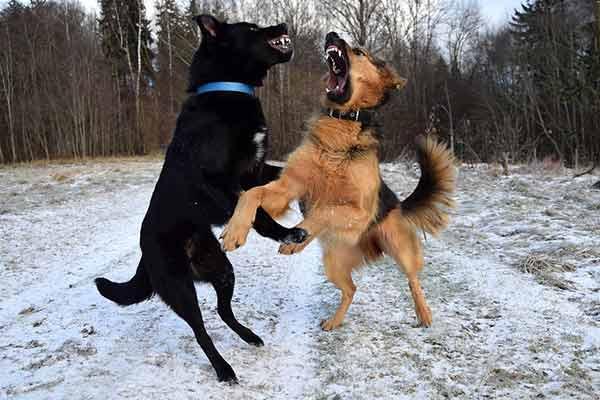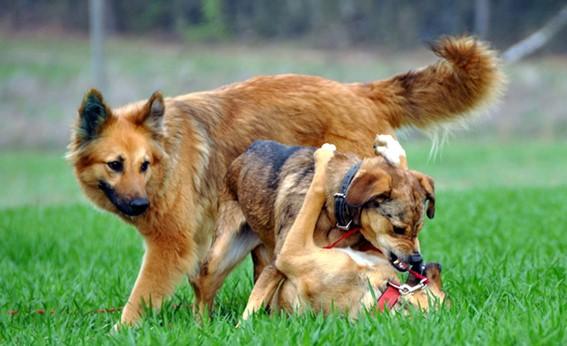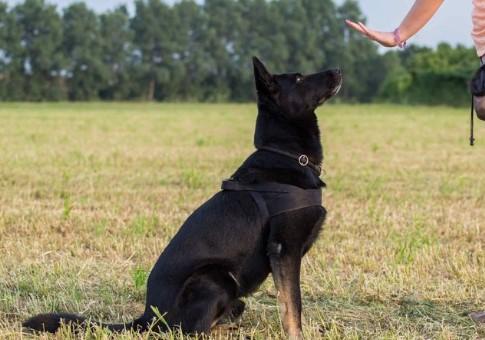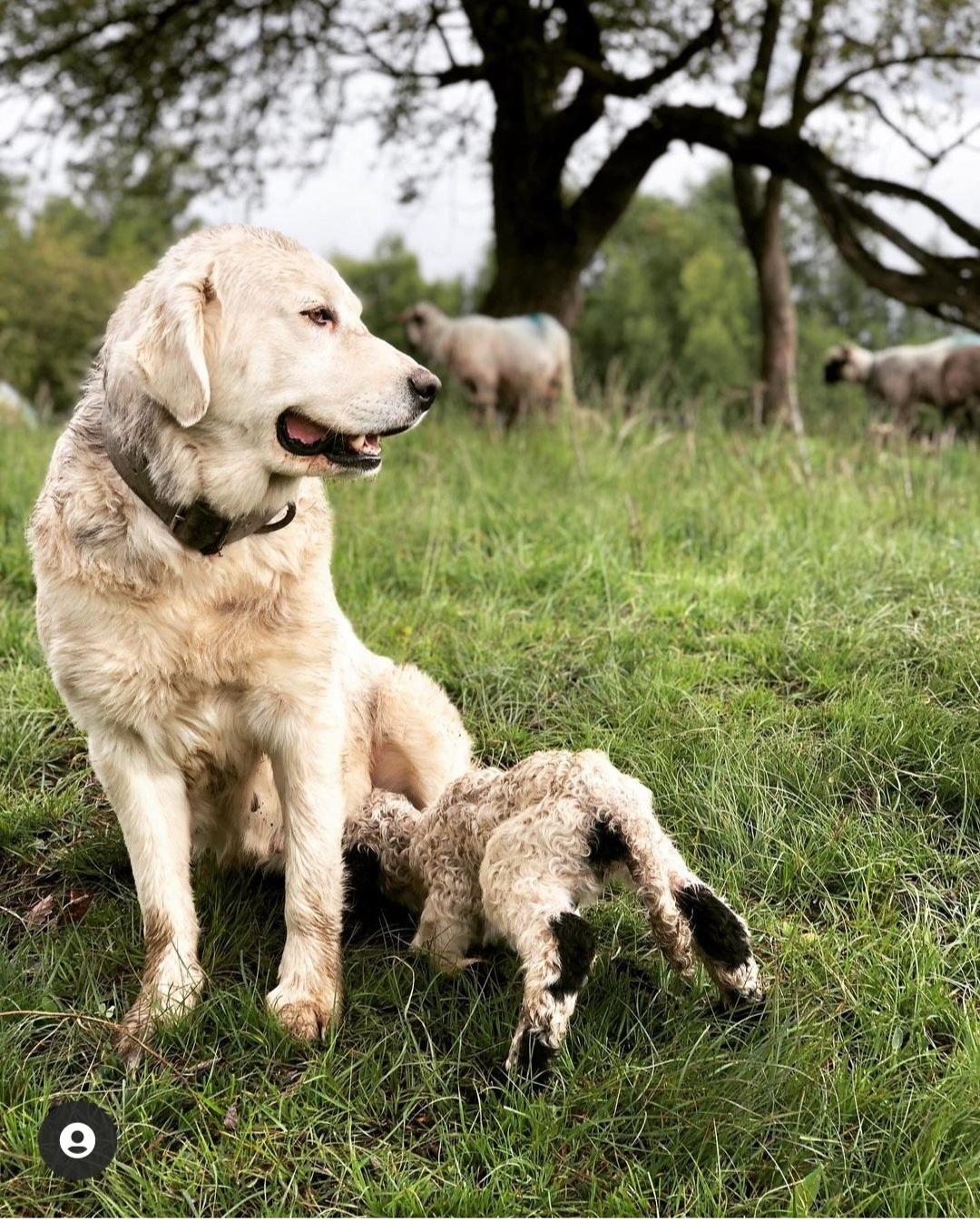
Attacks between two dogs, resulting in physical injury, psychological trauma or, in a few cases each year, death, are more common than we think. Nature and the living world are not kind, animals fight and sometimes kill each other for many reasons, within a species or during interspecific interactions. Protection of resources, territory, offspring, sexual conflicts, redirected aggression/irritation/distance, instrumentalized bites, pack effects, predation, possible behavioral disorders (hyperactivity, hyperreactivity), trauma, altered emotional/physiological states (illness, accident, taking medication, old age, etc.), fear/anxiety - these are just some of the causes that can provoke conflict.
It's vital to understand that an encounter between two dogs on a walk, in dog pension or when a new individual joins the household can never be predicted, nor can the outcome be known with any certainty. Now that we've understood the need to remove, at all costs, this "good dog/bad dog" interpretation, one obvious fact becomes clear : what will result from a face-to-face encounter between two dogs will depend on various factors, like everything that has to do with living beings ! At that point, two unique personalities, with their own genetics,epigenetics and personality/character, are interacting. Then there's the situation, the circumstances, the environment, the emotional/physiological state of the two protagonists at the time, the owner's management (fear, tension in the leash, failure to comply with requests made by one of them, etc.), past history/trauma and so on. As you can see, the relationship between two dogs is no more guaranteed than that between two humans. Antipathy, affinity, clinging, conflicts - anything can happen extremely quickly ! From a good understanding to aggression in a fraction of a second.
For the most part, conflicts don't last (if the dogs communicate well and know the calming signals), but they can be impressive for neophytes or people unfamiliar with canine communication. In fact, it's not uncommon, when observing owners at the moment of conflict, between barking and charging, to see them freeze, which means that the dog succeeds in provoking the desired behaviors even on the human.
On walks, conflicts are often due to fear, present following a possible aggression suffered by one of the dogs in the past and which has left stigmata. Or, sometimes, it can also stem from poor socialization, with dogs lacking the codes to interact properly with their fellow dogs. In the case of an anxious, traumatized dog, an immediate attack may occur, in order to defend himself, especially if this procedure worked during the initial aggression he suffered. This is what we call the dog's defense reflex, which originates in the reptilian cortex and is activated when the animal is panic-stricken, frightened and his survival is at stake. In such situations, the dog will trigger one or other of the following defense reflexes :
- Pretending The dog's doing something else, such as playing dead. Difficult to detect as he may also be licking, scratching,
sniffing the ground, etc.
- Freeze The dog stands still, crouches down and will most certainly use the famous calming signals, both to the other dog
and to his owner (to free him from the situation).
- Fleeing The fearful dog will try to flee, to get as far away as possible. He'll express this behavior when freezing
has not worked.
- Facing up Growling, biting, attacking. Behavior of dogs often on leash, unable to freeze or flee, or when cornered.
He attacks to defend himself.
In dogs pension or at home, conflicts/aggressions between dogs are often triggered by the need to protect resources (food), territory or even group defense aggression, which is very dangerous and can rapidly lead to death (aggression by a group of dogs on an individual, commonly known as the "pack effect"). There are also attacks due to distance or "competitive/social" aggression (object, resting place, social interaction or sexual control).

Conflicts between dogs are therefore frequent in everyday life, and vary in intensity/severity depending on the case, which in turn depends on the factors mentioned above. Even if dogs are mainly "non-conflict" and their communication is full of calming signals (mimics, postures, vocalizations), they are also conditioned by their genetics, instincts/behaviors and environment, among others. And in the latter, we often forget to mention the influence of the "human factor" and all that goes with it. Yes, it's undeniable that domestication or keeping animals in anthropized environments (parks/zoos) modifies behavior and increases the occurrence of intra- and interspecific conflicts. Examples of this are animals unable to escape from their congeners or owners, forced to confront situations that provoke fear and/or discomfort, living in high densities in environments that are not always suitable, having suffered various traumas (educational errors, accidents, aggression from congeners, non-compliant environments, confinement, solitude, mistreatment, etc.).
There is almost no mention of the abuses for which human is responsible with the dog, due on the one hand to his ignorance or, on the other, to his often too self-centered/supremacist thinking (the animal is inferior, less intelligent and must "serve" some purpose...) or, conversely, too anthropomorphic (infantilization). Nor is any mention made of the consequences, from behavioral disorders of varying degrees, such as reactivity, hyperreactivity and OCD, to anxiety, depression and self-mutilation. Needless to say, all of this is a breeding ground for aggression and conflict.
If your dog attacks or is attacked by a fellow dog, it's a good idea to calmly study the exact circumstances (once the situation is back to normal), taking into account what happened long before (altered emotional/physiological state, previous negative experience, etc.) to try and understand the reasons for the conflict and how to improve the situation if it happens again. Or seek advice from an educator or your vet. The owner's attitude also plays an important role, as anxiety and fear are perceived by the dog, for example in the way he holds the leash. This is the reason why dog training courses are so important, not to say crucial : owners learn to get to know the canine world and their own dog, to handle difficult situations and conflicts, to adopt appropriate behavior and intervene without risking their physical integrity.
Any owner who has never taken any dog training course and is unfamiliar with canine behavior runs a high risk of creating/provoking conflicts (directly or indirectly) or aggravating them through inappropriate behavior, which can also backfire (injuries/bites). This is often the case with small breeds of dog, who are victims of infantilization (carried in bags, dressed up, taken in the arms when in contact with other dogs, etc.). It's worth remembering that a dog is a dog and should be treated as such, i.e. by respecting HIS canine needs (and not ours, once again !), through species-specific communication. Any extreme, whatever the subject, is harmful and leads to more problems than solutions !
When it comes to conflicts, it's also worth remembering that moods and emotional/physiological states play a role in dogs, as they do in humans. A meeting between two dogs that have previously been in conflict can, at another time and under different circumstances, have a completely different outcome. This is sometimes the case in dogs pension : dogs who know each other, who have been in the same kennel or playpen many times before and who, at a given moment, for various reasons having to do with all the factors mentioned above, start fighting. Nothing is ever linear with living beings, and this example is further proof of that, if anyone still doubted it.
Yes, conflicts do arise between dogs, just as they do between humans, and this is normal. Yes, sometimes two fellow dogs fight, which can lead to physical injury (of varying degrees of severity), possible trauma and even death. However, we shouldn't systematically stigmatize or dramatize conflicts between canines. Not all dogs can get along at all times, in the same way as humans. What may seem impressive to canine neophytes (growling, snapping jaws, visible canine teeth) is a sign of visual or acoustic communication (vocalizations) in canines. The discussion can end there, without aggression, if the other dog understands the message, which is often the case. All owners should therefore be familiar with all aspects of agonistic behavior and situations that can lead to conflict, and learn to spot the warning signs.

That's why, in this dossier, we insist heavily on the need to take dog training courses (theoretical if possible, but in any case practical) and to read books on dogs when we decide to acquire one. At the risk of repeating ourselves, you need to understand that the lack of human knowledge about dog training and behavior increases the risk of making mistakes with potentially serious consequences, whether as users of public places or dog owners. As far as the latter are concerned, the absence or, even worse, poor socialization of a dog during his first few months (which are very important in his development), can spoil his life, and have consequences for his mental/emotional and physiological state, which, quite logically, will also increase the risk of conflicts or incidents ! All you need to do is be in a place where there are a dozen/twenty different dogs to observe behavioral problems of varying degrees, which show that the dog is not 100% at ease in his paws. And this has an influence on the dog's life in society, with other dogs and with humans.
It is therefore imperative for every owner to be familiar with the canine world (instincts/behaviors/functioning), but also and above to know his own companion (personality/character), that he knows how to interpret the signs showing changes in state, the parameters that can provoke conflicts and that he respects, at all times, other users and their wishes ! An example can be given to describe a situation encountered extremely frequently by dog owners : you are walking your dog on a leash because you know he is reactive to other dogs (for various reasons that should not be judged) or simply because he is not in a normal state that day (illness, injury, pain, taking medication, etc.). You then come across a person with unleashed dog, who you kindly ask to call back and hold or tie up his dog for the duration of the crossing. Many owners will reply "No need, my dog is friendly"! Now that you have a deeper understanding of canine instincts, behaviors and functioning, you'll better understand the need to respect all requests and even anticipate them, whether to avoid conflict or for the well-being of any users who cross your path. Bear this in mind : you may know your dog, but not the one across the street !
In terms of official veterinary statistics, the figures for the French-speaking cantons for the year 2022 show between 300 and 350 dog attacks on fellow human beings. And these are only the cases that have been announced as having probably caused physical damage. Desensitization therapies are also carried out on dogs traumatized by aggression, something we never talk about. Every year, a few dogs lose their lives in intraspecific attacks, demonstrating the extremely high degree of risk of aggression and injury that exists between two domestic dogs rather than between dogs and wolves.
We can't close this chapter without mentioning the guardian dog, which is a key concern for many owners during the summer season. Let's be clear, once and for all : a domestic dog has no place on a mountain pasture protected by guardian dogs, whether on or off leash ! Now that you've hopefully acquired a better grounding in canine behavior, you should instinctively understand that it's a huge mistake to disturb a working dog protecting his herd from...another canine !
The panels at the start of hiking trails and the instructions given each year are clear. If people do not respect them, they will find themselves in an extremely complicated situation to manage, especially if their knowledge of the dog world is poor. Interactions will be agonistic, simply because the domestic dog will be perceived as a wolf, a threat to the herd's safety. Mistakes such as fleeing, hugging or forcing their way in will undoubtedly lead to bites or aggression, potentially fatal for small dog breeds. But make no mistake: in this situation, the fault is 100% human ! Most regrettably, the breeder runs the risk of being inconvenienced simply because people have disregarded the instructions and signs. There are many beautiful walks and hikes to be made with your dog outside the summer pastures protected by guardian dogs. To find out where you can find guardian dogs in Switzerland, click on the following two links :
Carte interactive AGRIDEA
ARCADIA - Liste des élevages
"We do not provide educational solutions or diagnose intraspecific conflicts under any circumstances. As dogs are unique beings, with their own genetics, epigenetics and environment, it is imperative to consult a professional/specialized educator and/or a veterinary behaviorist in the event of difficulties encountered with your companion. This way, you can avoid conflicts or incidents with other dogs or humans, but above all - and this is the most important thing - you can allow your companion to be treated, by correcting any educational errors, and make him happier".
Dictionary
Deviance Character of deviation from the norm.
Interspecific Concerning two different species and their relationships.
Intraspecific Everything that occurs within the same biological species.
Epigenetic Everything that comes from parental upbringing, learning and experience throughout
an individual's life, whether positive or negative.
Agonistic Leading to conflict, aggression, biting (unfriendly relationships)
Photos : illustration, lemagduchien, japhy, C. Jeannerat
NEXT CHAPTER : BETWEEN DOG AND WOLF
